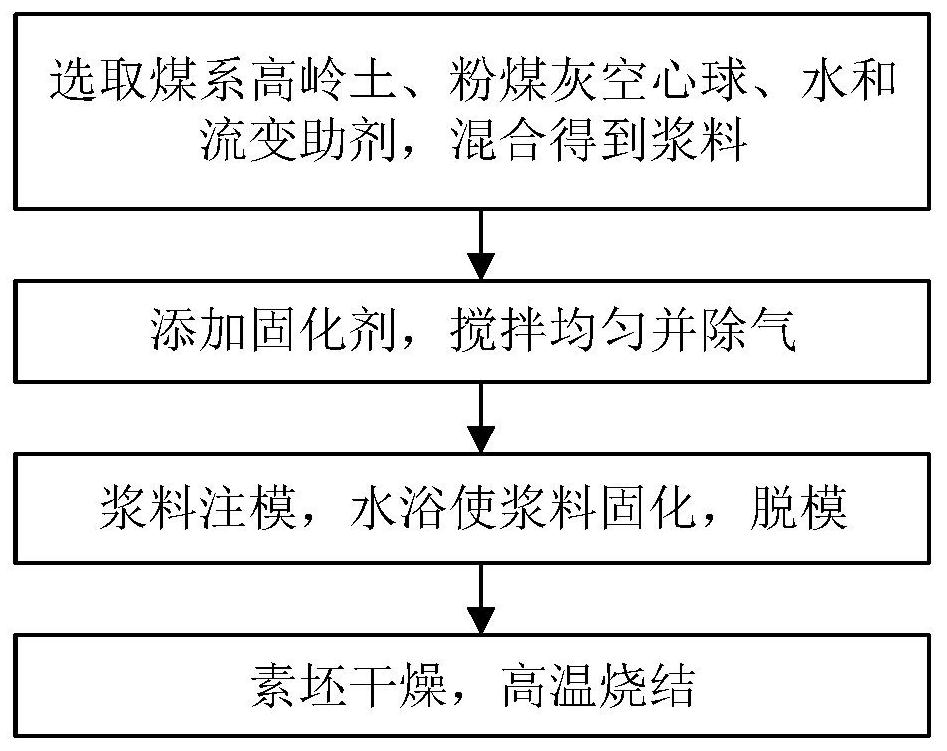Preparation method of fully closed-cell porous mullite ceramics based on direct solidification injection molding
A porous mullite, injection molding technology, applied in the direction of ceramic products, ceramic material production, clay products, etc., can solve the problems of difficulty in obtaining porous ceramics with a fully closed-cell structure, long preparation period, etc., to ensure excellent performance, Low cost of raw materials and simple operation
- Summary
- Abstract
- Description
- Claims
- Application Information
AI Technical Summary
Problems solved by technology
Method used
Image
Examples
preparation example Construction
[0026] like figure 1 As shown, the present invention provides a method for preparing a fully closed-cell porous mullite ceramic based on direct solidification injection molding, the method comprising the following steps:
[0027] S1 Mix kaolin powder, fly ash hollow spheres, deionized water and rheological additives, and use high-speed shearing or mechanical stirring to prepare uniformly dispersed ceramic slurry;
[0028] S2 Add a curing agent to the ceramic slurry and mix it evenly, and then degas it by vacuum degassing or centrifugal degassing to obtain a mixed slurry;
[0029] S3, inject the mixed slurry into the mold, and then heat it for 0.5h-2h in a water bath at 50°C to 90°C to solidify, and obtain a ceramic green body after demoulding;
[0030] S4: Dry the ceramic green body at a temperature of 50℃~90℃ for 12h~24h, and finally put the dried ceramic green body in a sintering furnace, and sinter it at a high temperature of 1350℃~1600℃ for 1h~2h, so as to The fully clos...
Embodiment 1
[0037] S1 Mix 45g of coal-based kaolin powder, 15g of fly ash hollow spheres and 40g of deionized water, and use high-speed shearing to prepare a ceramic slurry with a solid content of 60wt%, wherein the particle size of the fly ash hollow spheres is is 90μm;
[0038] S2 is added with calcium iodate in the ceramic slurry at a ratio of 8g / L and mixed evenly, and then degassed by vacuum degassing to obtain a mixed slurry;
[0039] S3, inject the mixed slurry into the silica gel mold, keep the mixture in a water bath at 70°C for 1 h to solidify the mixed slurry, and obtain a ceramic china after demoulding;
[0040]In S4, the ceramic green body was dried at 90 °C for 12 h, and sintered at 1550 °C for 1 h to obtain fully closed-cell porous mullite ceramics.
Embodiment 2
[0042] S1 Mix 20g of coal-based kaolin powder, 50g of fly ash hollow spheres, 30g of deionized water and 0.3g of cellulose, and use mechanical stirring to prepare a ceramic slurry with a solid content of 70% by weight, wherein the fly ash is hollow The particle size of the ball is 20 μm;
[0043] S2 is added with barium iodate in the ceramic slurry at a ratio of 6g / L and mixed evenly, and then degassed by vacuum degassing to obtain a mixed slurry;
[0044] S3: inject the mixed slurry into the silica gel mold, heat the mixed slurry for 0.5h in a water bath at 90°C to solidify the mixed slurry, and obtain a ceramic china after demoulding;
[0045] S4 The ceramic green body was dried at 65 °C for 20 h, and sintered at 1350 °C for 2 h to obtain fully closed-cell porous mullite ceramics.
PUM
| Property | Measurement | Unit |
|---|---|---|
| particle diameter | aaaaa | aaaaa |
| particle diameter | aaaaa | aaaaa |
| particle diameter | aaaaa | aaaaa |
Abstract
Description
Claims
Application Information
 Login to View More
Login to View More - R&D Engineer
- R&D Manager
- IP Professional
- Industry Leading Data Capabilities
- Powerful AI technology
- Patent DNA Extraction
Browse by: Latest US Patents, China's latest patents, Technical Efficacy Thesaurus, Application Domain, Technology Topic, Popular Technical Reports.
© 2024 PatSnap. All rights reserved.Legal|Privacy policy|Modern Slavery Act Transparency Statement|Sitemap|About US| Contact US: help@patsnap.com








